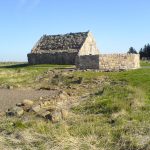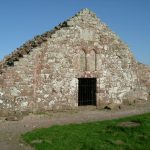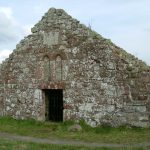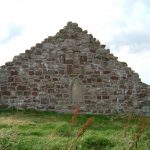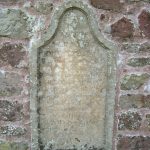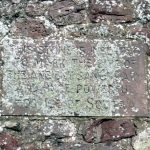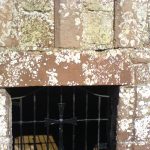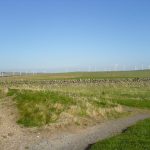Soutra Aisle
Pringle’s of Soutra Aisle
Formally the Collegiate Church of Holy Trinity Hospital of Soltre (of the Red Friars).
Founded by Malcolm IV in 1164 and superseded by Trinity Hospital in Edinburgh in 1460.
Location
Located on the western flank of Soutra Hill, 2 miles (3 km) southeast of Fala is the noted Soutra Aisle. It lies just to the northwest of Dun Law, with its wind farm, and just within the Scottish Borders at its boundary with Midlothian. (It’s well signposted off the A68 trunk Road – South of Dalkeith and Fala village, Midlothian). You can see 60 peaks clearly from the Soutra Aisle. – The Pentlands, Ochils, Sidlaws, Lomonds and the majestic sweep of the Firth of Forth.
History
Soutra Aisle is all that remains of a grand hospital, monastery and church which occupied a location half-way between Edinburgh and the Borders Abbeys. Served by what was at the time the most important road in southern Scotland, Dere Street, built by the Romans but still the main route south from Edinburgh for many centuries afterwards. Parts of Dere Street remain and can still be traced on the ground near the Aisle
At first sight, Soutra Aisle isn’t obviously all that remains above ground of one of the most important institutions in medieval Scotland. Yet in its heyday, the House of the Holy Trinity at Soutra was one of the three most important hospitals in Scotland and occupied a walled area measuring some 700m square. The House of the Holy Trinity at Soutra, as the mediaeval hospital was formally known, was founded by the Augustinians at the request of King Malcolm IV in about 1160, and run by Augustinian monks to assist the poor, travellers and pilgrims, the aged, sick, the infirm and sanctuary to fugitives. Funding came from vast monastic estates which were augmented by benefactors grateful for their treatment in the hospital. It was undoubtedly the largest and best endowed hospital of mediaeval Scotland.
Royal road for pilgrims
Soutra Medieval Augustinian Hospital was certainly established by the 12th century. In 1164 AD King Malcolm IV “confirmed the foundation charter”. It was a refuge for travellers, pilgrims, the aged and the needy, midway between Edinburgh and the Border Abbeys on the Via Regia (royal road). In the 12th century it would have been funded by income from estates covering 20 square miles.
Archaeology
Soutra Medieval hospital has been the site of unique ” archaeo-medical investigation” (1986-now.) Exploring actual medical practice in Southern Scotland, through the distinctive waste produced. Augustinian medicine was mainstream and well funded. The research analyzed waste from mud on the site, compared it with medieval medicine recipes…..and was able to draw conclusions about medical practices and patient outcomes. Perhaps this research will show us old and forgotten medical practices which can still apply today. Archaeological excavations since 1986 have found traces of medicinal products from all over the known world, including cloves from Eastern Africa. Also found in one of the cellars were traces of a mixture of the seeds of hemlock, black henbane and opium poppy, used as a general anesthetic in the case of amputations. Calculating the correct dose of this highly poisonous mixture must have been fairly critical to the survival of the patient.
Archaeological excavations have given a unique insight into mainstream mediaeval medical practice, through the discovery of human remains and the residues of herbal treatments. However, only very limited evidence remains of the numerous buildings which would once have existed.
Decline
Soutra Hospital declined following a scandal in 1460 when a renegade Master, Stephen Fleming, was deposed after many offences were reported to Papal authorities. The Scottish Crown then confiscated most of Soutra’s estates and re-assigned them to the new “Trinity College Hospital” (now beneath Waverley Train station on Princes Street, Edinburgh). At the stroke of a Royal signature Soutra was impoverished. Thus a hospital of international status was reduced to local significance. Soutra hospital struggled on until around 1650 as a local service. Soutra’s loss of course laid the foundations for Edinburgh to become a medical center of international renown. Soutra Asle was restored in 1998 after its collapse.
The Pringles of Soutra
Soutra Aisle is just a fragment of the church and it survives only because it became the family burial vault of the Pringles of Soutra/Beatman’s Acre in 1686.
The Pringles of Soutra, in Alex Pringle’s book ‘The Records of the Pringles of the Scottish Border’.
- Robert Hoppringill, rector of Morham (brother of George Hoppringill of Torwoodlee), d. 1582.
- Robert Hoppringill, who predeceased his father.
- William Hoppringill in Milton d. 1635
- Robert Hoppringill of Templehalls and Woodhead, W.S., also laird of Whitburgh and Blackhouse.
- John Pringill of Woodhead, d. 1659.
- John Pringle of Woodhead
- Alexander Pringle
- Robert Pringle
- John Pringle
- David Pringle in Templehalls
- David Pringle, d. 1754
- David Pringle
- Andrew Pringle in Ballincrieff Mains
- Andrew Pringle of Borgue in Kirkcudbrightshire
- Andrew Pringle of Borgue and Lann Hall, M.D. d. 1858 in London.
- Andrew Pringle of Banstead, Surrey. d. 1893. Author of Practical Micro-Photography.
- Robert-Hunter Pringle, Asst. Commissioner of the Royal Commission of Agriculture.
- John-James Pringle, a Dermatologist at Middlesex Hospital, London. Died in New Zealand in 1922.
- Andrew Pringle of Borgue and Lann Hall, M.D. d. 1858 in London.
- John Pringle, W.S. and Deputy Clerk of Session
- Andrew Pringle of Borgue in Kirkcudbrightshire
- David Pringle, d. 1754
- John Pringle of Woodhead
- Robert Pringill of Dewar, W.S.
- John Pringill of Woodhead, d. 1659.
- John Pringill in Milton; laird of Soutra and Blackshiels (2nd son of William in Milton), d. 1650.
- William Pringill of Soutra
- Robert Pringill of Blackshiels (succeeded his brother to Soutra).
- Agnes Pringle, married David Pringle brother of John of Woodhead. d. 1686. – Their initials can be seen over the door of Soutra Aisle.
- Margaret Pringle
- Agnes Pringle, married David Pringle brother of John of Woodhead. d. 1686. – Their initials can be seen over the door of Soutra Aisle.
- John Pringill in Milton
- Lilias Pringle, married David Pringle in Templehalls (see above).
- George Pringill
- John Hoppringill, the younger, of Magray
- John Pringill
- William Hoppringill in West Pencaitland
- George Hoppringill in Magray
- James Hoppringill in East Spott Mill
- Robert Hoppringill of Templehalls and Woodhead, W.S., also laird of Whitburgh and Blackhouse.
- John Hoppringill
The Pringles of Fountainhall and Soutra. Proceedings of the Society of Antiquaries of Scotland 58. Vol 58, pp. 302-308. By Pringle, A., (1923).

